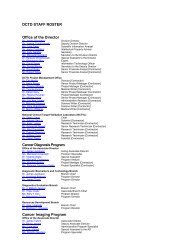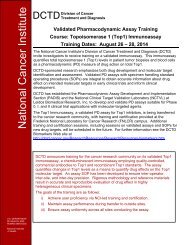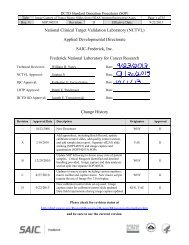National Cancer Institute - NCI Division of Cancer Treatment and ...
National Cancer Institute - NCI Division of Cancer Treatment and ...
National Cancer Institute - NCI Division of Cancer Treatment and ...
Create successful ePaper yourself
Turn your PDF publications into a flip-book with our unique Google optimized e-Paper software.
was about three times greater than that<br />
found using three independent pools per<br />
treatment class. Also, probe set-specific<br />
variability in pools was greater than that<br />
in individuals for more than 60 percent <strong>of</strong><br />
the cases.<br />
Lusa L, Cappelletti V, Gariboldi M, Ferrario C,<br />
DeCecco L, Reid JF, T<strong>of</strong>fanin S, Gallus G, McShane<br />
LM, Diadone MG, Pierotti MA. Caution regarding<br />
the utility <strong>of</strong> pooling samples in microarray<br />
experiments with cell lines. Submitted to<br />
BioTechniques.<br />
BRB staff members Drs. Dobbin <strong>and</strong> Simon<br />
developed methods for planning sample<br />
size for studies whose objective is to identify<br />
genes that are differentially expressed<br />
among phenotypic or genotypic classes<br />
<strong>of</strong> tissue. They have considered how sample<br />
size depends on the microarray hybridization<br />
design utilized with dual label<br />
arrays <strong>and</strong> have considered a wide range<br />
<strong>of</strong> designs, including the common reference<br />
design, balanced block design, <strong>and</strong><br />
loop design. They have also developed<br />
a method for sample size planning <strong>of</strong><br />
clinical studies whose objective is to<br />
develop a predictor <strong>of</strong> outcome or predictor<br />
<strong>of</strong> phenotypic/genotypic class based<br />
on whole genome expression pr<strong>of</strong>iling.<br />
Dobbin K, Simon R. Sample size determination<br />
in microarray experiments for class comparison<br />
<strong>and</strong> prognostic classification. Biostatistics<br />
2005:6;27–38.<br />
Dobbin K, Simon R. Sample size planning<br />
for developing classifiers using high dimen-<br />
sional DNA expression arrays. Submitted for<br />
publication.<br />
Drs. Dobbin <strong>and</strong> Simon also studied the<br />
role <strong>of</strong> dye bias not removed by st<strong>and</strong>ard<br />
normalization methods. They corrected<br />
commonly held misconceptions about<br />
the implication <strong>of</strong> dye bias for the design<br />
Affymetrix GeneChip® probe array.<br />
<strong>of</strong> dual-label microarray studies <strong>and</strong> also<br />
corrected a statistical modeling flaw that<br />
had appeared in the literature that had<br />
led to erroneous conclusions about<br />
how to design <strong>and</strong> analyze microarray<br />
experiments.<br />
Dobbin KK, Kawasaki ES, Petersen DW, Simon<br />
RM. Characterizing dye bias in microarray experiments.<br />
Bioinformatics 2005:21;2430–7.<br />
Dobbin KK, Shih JH, Simon RM. Comment on<br />
“Evaluation <strong>of</strong> the gene-specific dye bias in<br />
cDNA microarray experiments.” Bioinformatics<br />
2005:21;2803–4.<br />
Dobbin K, Simon R. Experimental design in<br />
expression pr<strong>of</strong>iling. In: Encyclopedia <strong>of</strong> Genetics,<br />
Proteomics <strong>and</strong> Bioinformatics. Jorde L, ed. New<br />
York: John Wiley & Sons; 2005.<br />
The goal <strong>of</strong> many gene-expression microarray<br />
pr<strong>of</strong>iling clinical studies is to develop<br />
a multivariate classifier to predict patient<br />
disease outcome from a gene expression<br />
pr<strong>of</strong>ile measured on some biological<br />
specimen from the patient. Techniques<br />
such as cross-validation or bootstrapping<br />
can be used in this setting to assess predictive<br />
power <strong>and</strong>, if applied correctly,<br />
can result in a less biased estimate <strong>of</strong><br />
predictive accuracy <strong>of</strong> a classifier. However,<br />
some investigators have attempted<br />
to apply st<strong>and</strong>ard statistical inference<br />
procedures to assess the statistical significance<br />
<strong>of</strong> associations between true <strong>and</strong><br />
cross-validated predicted outcomes.<br />
B I O M E T R I C R E S E A R C H B R A N C H ■ 19<br />
Affymetrix.










